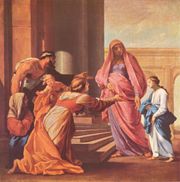
Eustache Le Sueur
Encyclopedia


His early death and retired habits led to various fables attaching to his life, in a similar way to Claude Lorrain
Claude Lorrain
Claude Lorrain, , traditionally just Claude in English Claude Lorrain, , traditionally just Claude in English (also Claude Gellée, his real name, or in French Claude Gellée, , dit le Lorrain) Claude Lorrain, , traditionally just Claude in English (also Claude Gellée, his real name, or in French...
. We are told that, persecuted by Le Brun
Charles Le Brun
Charles Le Brun , a French painter and art theorist, became the all-powerful, peerless master of 17th-century French art.-Biography:-Early life and training:...
, who was jealous of his ability, he became the intimate friend and correspondent of Poussin
Nicolas Poussin
Nicolas Poussin was a French painter in the classical style. His work predominantly features clarity, logic, and order, and favors line over color. His work serves as an alternative to the dominant Baroque style of the 17th century...
, and it is added that, broken-hearted at the death of his wife, Le Sueur retired to the monastery of the Chartreux and died in the arms of the prior.
All this, however, is pure fiction. The facts of Le Sueur's life are these. He was the son of Cathelin Le Sueur, a turner and sculptor in wood, who placed his son with Vouet
Simon Vouet
Simon Vouet was a French painter and draftsman, who today is perhaps best remembered for helping to introduce the Italian Baroque style of painting to France.-Life:...
, in whose studio he rapidly distinguished himself. Admitted at an early age into the guild of master-painters, he left them to take part in establishing the academy of painting and sculpture, and was one of the first twelve professors of that body.
Some paintings, illustrative of the Hypnerotomachia Poliphili
Hypnerotomachia Poliphili
Hypnerotomachia Poliphili , called in English Poliphilo's Strife of Love in a Dream, is a romance said to be by Francesco Colonna and a famous example of early printing...
, which were reproduced in tapestry, brought him into notice, and his reputation was further enhanced by a series of decorations (Louvre
Louvre
The Musée du Louvre – in English, the Louvre Museum or simply the Louvre – is one of the world's largest museums, the most visited art museum in the world and a historic monument. A central landmark of Paris, it is located on the Right Bank of the Seine in the 1st arrondissement...
) in the mansion of Lambert de Thorigny, which he left uncompleted, for their execution was frequently interrupted by other commissions. Amongst these were several pictures for the apartments of the king and queen in the Louvre, which are now missing, although they were entered in Bailly's inventory (1710); but several works produced for minor patrons have come down to us.
In the gallery of the Louvre are the "Angel and Hagar," from the mansion of De Tonnay Charente; "Tobias and Tobit," from the Fieubet collection; several pictures executed for the church of Saint Gervais; the "Martyrdom of St Lawrence," from Saint Germain de l'Auxerrois; two very fine works from the destroyed abbey of Marmoutiers; "St Paul preaching at Ephesus," one of Le Sueur's most complete and thorough performances, painted for the goldsmiths corporation in 1649; and his famous series of the "Life of St Bruno," executed in the cloister of the Chartreux. These last have more personal character than anything else which Le Sueur produced, and much of their original beauty survives in spite of injuries and restorations and removal from the wall to canvas. The Louvre also possesses many fine drawings (reproduced by Braun), of which Le Sueur left an incredible quantity, chiefly executed in black and white chalk.
His pupils, who aided him much in his work, were his wife's brother, Tb. Gouss, and three brothers of his own, as well as Claude Lefebvre
Claude Lefebvre (artist)
Claude Lefebvre was a French painter and engraver.-Early life:Lefebvre was born at Fontainebleau. He studied art under Eustache Le Sueur and Charles Le Brun at Fontainebleau.-Career:...
and Pierre Patel
Pierre Patel
Pierre Patel , was a French painter.Patel was admitted to the Guild of Saint-Germain-des-Prés in 1633, and the Académie de Saint-Luc in 1635. He primarily painted landscapes. In 1648 he had a son Pierre-Antoine Patel, who also became a painter. Patel died in Paris in 1676.-References:...
the landscape painter. Most of his works have been engraved, chiefly by Picart, B. Audran, Seb. Leclerc, Drevet, Chauveau, Poilly and Desplaces.
It is considered that Le Sueur's work lent itself readily to the engraver's art, as he had a delicate perception of varied shades of grave and elevated sentiment, and possessed the power to render them. His graceful facility in composition was always restrained by a very fine taste, but his works often fail to please completely, because, producing so much, he had too frequent recourse to conventional types, and partly because he rarely saw colour except with the cold and clayey quality proper to the school of Vouet
Simon Vouet
Simon Vouet was a French painter and draftsman, who today is perhaps best remembered for helping to introduce the Italian Baroque style of painting to France.-Life:...
; yet his "St Paul at Ephesus" and one or two other works show that he was not naturally deficient in this sense, and whenever we get direct reference to nature—as in the monks of the St Bruno series – we recognize his admirable power to read and render physiognomy
Physiognomy
Physiognomy is the assessment of a person's character or personality from their outer appearance, especially the face...
of varied and serious type.

